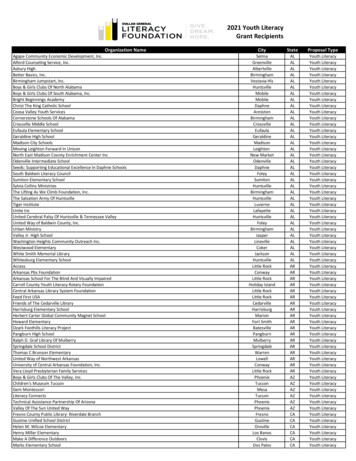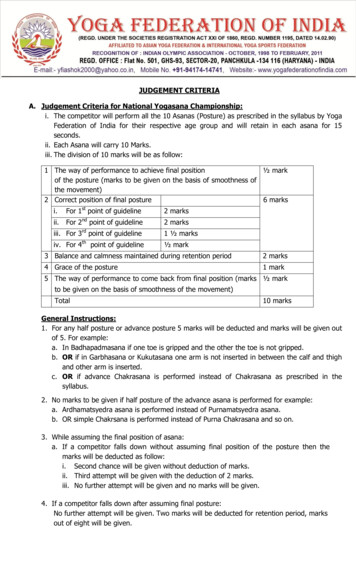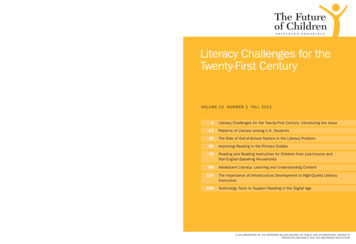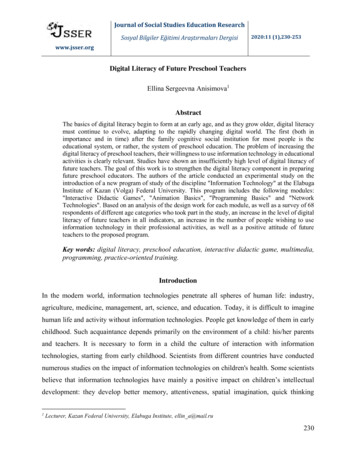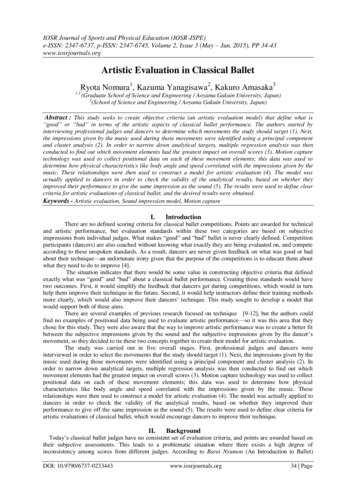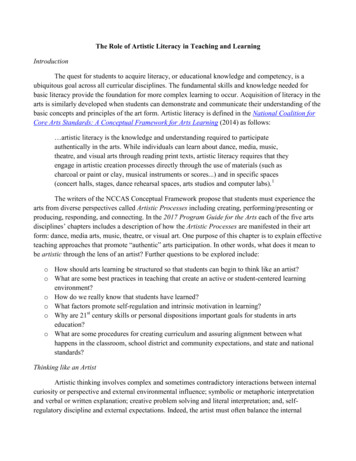
Transcription
The Role of Artistic Literacy in Teaching and LearningIntroductionThe quest for students to acquire literacy, or educational knowledge and competency, is aubiquitous goal across all curricular disciplines. The fundamental skills and knowledge needed forbasic literacy provide the foundation for more complex learning to occur. Acquisition of literacy in thearts is similarly developed when students can demonstrate and communicate their understanding of thebasic concepts and principles of the art form. Artistic literacy is defined in the National Coalition forCore Arts Standards: A Conceptual Framework for Arts Learning (2014) as follows: artistic literacy is the knowledge and understanding required to participateauthentically in the arts. While individuals can learn about dance, media, music,theatre, and visual arts through reading print texts, artistic literacy requires that theyengage in artistic creation processes directly through the use of materials (such ascharcoal or paint or clay, musical instruments or scores.) and in specific spaces(concert halls, stages, dance rehearsal spaces, arts studios and computer labs). 1The writers of the NCCAS Conceptual Framework propose that students must experience thearts from diverse perspectives called Artistic Processes including creating, performing/presenting orproducing, responding, and connecting. In the 2017 Program Guide for the Arts each of the five artsdisciplines’ chapters includes a description of how the Artistic Processes are manifested in their artform: dance, media arts, music, theatre, or visual art. One purpose of this chapter is to explain effectiveteaching approaches that promote “authentic” arts participation. In other words, what does it mean tobe artistic through the lens of an artist? Further questions to be explored include:o How should arts learning be structured so that students can begin to think like an artist?o What are some best practices in teaching that create an active or student-centered learningenvironment?o How do we really know that students have learned?o What factors promote self-regulation and intrinsic motivation in learning?o Why are 21st century skills or personal dispositions important goals for students in artseducation?o What are some procedures for creating curriculum and assuring alignment between whathappens in the classroom, school district and community expectations, and state and nationalstandards?Thinking like an ArtistArtistic thinking involves complex and sometimes contradictory interactions between internalcuriosity or perspective and external environmental influence; symbolic or metaphoric interpretationand verbal or written explanation; creative problem solving and literal interpretation; and, selfregulatory discipline and external expectations. Indeed, the artist must often balance the internal
processes of creativity with conflicting forces of the world around them. Teaching students to thinklike an artist is challenging, indeed.Arts educators were tasked in the 1994 National Standards for the Arts to foster students’acquisition of arts skills and knowledge. The nine content standards were the result of decades ofdiscussions by arts educators who came to a general consensus regarding what was important to knowand be able to do in the arts. This significant step in identifying the core knowledge and skills neededto understand and make art provided a framework for curriculum development and assessmentpractices for 20 years. Language from the standards document itself clarifies this:Standards for arts education are important for two fundamental reasons.First, they help define what a good education in the arts should provide: athorough grounding in a basic body of knowledge and the skills required bothto make sense and to make use of each of the arts disciplines An educationin the arts means that students should know what is spelled out here, reachspecified levels of attainment, and do both at defined points in their education.Put differently, arts standards provide a vision of both competence andeducational effectiveness, but without creating a mold into which all artsprograms must fit. 2The 1994 standards articulated the knowledge and skills that arts education should provide. Incontrast, the 2014 National Core Arts Standards (adopted by Connecticut as the Connecticut ArtsStandards) embed specific artistic knowledge and skills. The standards focus on the learning inherentin the Artistic Processes, then refined and defined by the Process Components from each of the fivearts disciplines. The chart below lists many of the process components found in the arts standards.Process Components in the Arts StandardsDANCEMEDIA ARTSMUSICTHEATERVISUAL lateConveyCritiqueImaginePlan and stigatePlan & eInterpretElaborateCompare
Core arts knowledge and skills are implied in the 2014 National Core Arts Standards requiringteachers to now aim their learning goals toward the artistic processes that promote artistic thinking andultimately artistic literacy. In reviewing the process components in the chart, it is clear that these verbsrepresent higher order thinking and are meant to develop 21st century dispositions and work placeskills. The challenge for arts educators, often faced with restrictions of time and resources, is toprovide the necessary support and guidance to help students achieve these goals. What are instructionalpractices that may help accomplish this?Best Practices for Active/Student Centered InstructionArts classes by their nature are places where students are involved in active learning. Studentsperform music, create art, present a play, dance to music, or invent new media. Teachers often modelor use direct instruction so that students receive explicit guidance in executing their art. Any artseducator will agree that their exemplar is critical to the students’ learning processes. However, thissegment of the instruction represents just part of the instructional puzzle. Students may mimic what theteacher models, but true artistic literacy also involves artistic thinking on the part of the student.Looking back at the process components, we see that student self-regulation and independence iscritical to addressing the artistic processes. As arts educators, it is necessary to teach the coreknowledge and skills but also with an eye toward developing students’ personal dispositions. Thisstudent-centered instruction “encompasses a wide array of practices that bring students into the processof assessing their growth and learning. They gain a deeper sense of their progress and ultimatelybecome more independent learners.” 3 This idea of a three-pronged approach to teaching in an active orstudent-centered classroom may be represented by the following graphic:Teaching for Artistic Literacy 4In active learning- or student-centered arts classrooms students not only engage in making theart, they are given time to make connections with their own cultural background, assess their techniqueand understanding, interact with peers, and participate in evaluating their own progress. The process is
cyclical as learning progresses. Teacher-led instruction is sometimes as necessary for advancedlearners as it is for novice learners. Collaborative and independent learning opportunities often occurfluidly within a single lesson. The chart below provides some examples of active, student-centeredlearning in arts classrooms.In a Student-Centered Arts Classroom, Students .Set personal goalsPlan and create their own workSelf and peer evaluateConduct student led rehearsalsWrite art or performance critiquesLead student-researched program or production notesCollaborate in developing artistic products, programs, plots,movementCollaborate in design/problem solving/analysisActively engage in error detection & revisingAssist in determining presentations, concerts, or showsAnd more .The Role of Inquiry and FeedbackTo accomplish these types of learner-centered activities in the arts classroom the teacher’s rolemoves to that of facilitator of the learning rather than the distributor of knowledge. “When placed on acontinuum of active student involvement, one end of the continuum represents little or some studentinvolvement versus the opposing end that represents mostly student-driven learning. In other words, ifthe beliefs, theories, or perspectives of the instructor or governing bodies perceive that the student is atthe center of the learning experience then those factors will serve as the center of how the curriculum isdeveloped.” 5If students have had little or no experiences in guiding their own learning, they must be givendirection for learning to do so. Even young children may be asked to rate their own work indicated bymarking symbols on a colorful check list or rubric, or raising hands. The ability to tactfully andrespectfully peer evaluate or work in collaboration is a critical life skill that should begin early in theirschool lives and remain a standard throughout the school years. A few ideas for establishingmeaningful collaboration and communication in arts classrooms include: Establishing classroom guidelines (developed with student input) and posted for reference;Creating key words or symbols as non-verbal reminders for students to maintain respectfulbehavior;Scaffolding and blending direct instruction, modeling, and student-led work; andProviding teacher–led and ultimately student-led questions that inspire students to think about,reflect, and articulate their perspectives on artistic work.
Productive and scaffolded questioning skills are keys to an active learning classroom. Wellformulated questions, cues, or prompts promote active learning, encourage diverse types ofthinking including problem-solving and reasoning, foster collaboration and social skills, and helpstudents think and reflect for themselves. The goal is for students to become self-regulated learnersboth at school and in life. Many types of questioning techniques exist in education: Bloom’s Taxonomy, the original published in 1956, and its revision in 2001, havetraditionally provided a basis for evaluating levels of cognition. In the revision, thetaxonomy ordered cognition levels and added different types of thinking. The Depths of Knowledge (DOK) model categorizes four levels of activities and questionstarters: Recall, Skills/Concepts, Strategic Thinking, and Extended Thinking. Socratic Questions challenge students in six areas: Conceptual clarification questions tohelp students probe their own thinking for deeper levels; Probing assumptions helpsstudents think about their presuppositions and unquestioned beliefs; Probing rational,reasons and evidence challenges students to provide rationales and reasoning for theirbeliefs; Questioning viewpoints and perspectives asks students to consider other equallyvalid viewpoints than their own; Probing implication and consequences challenges studentsto consider the outcomes of their thinking or decisions; and, Questioning the questionsrequires students to consider what about their questions were important in the first place. Question-Answer-Response questions begin with Right There questions-fundamental, easyto identify through seeing or hearing (e.g. colors, lines, positions, tempos, symbols).Think and Search questions ask students to look through the music, script, artwork, ormovement to find and describe arts elements and principles; Author and Me questionsrequire some prerequisite knowledge. The questions deal with perceived emotionalresponses, interpretations, ideas that arise from the work itself; and, On My Own questionsthat ask students to “think outside of the box” by predicting, providing rationales,challenging reasons and evidence.For arts educators, all of these techniques are usable in arts classrooms and studios, rehearsals, andproductions. However, most of these techniques place more significance on cognitive rather thancreative and affective thinking. David Krathwohl, co-author of Taxonomy of Educational Objectives,The Affective Domain described the affective taxonomy as “ objectives which emphasize a feelingtone, an emotion, or a degree of acceptance or rejection. Affective objectives vary from simpleattention to selected phenomena to complex but internally consistent qualities of character andconscience.” 6 A statement in the 1994 National Standards for the Arts best summarizes what thismeans for arts education.
Standards identify what our children must know and be able to do. Thus, thevision embedded in these Standards insists that a mere nodding acquaintancewith the arts is not enough to sustain our children’s interest or involvement inthem. The Standards must usher each new generation onto the pathway ofengagement, which opens in turn onto a lifetime of learning and growth throughthe arts. It is along this pathway that our children will find their personaldirections and make their singular contributions. It is along this pathway, as well,that they will discover who they are, and even more, who they can become. 7“In this single statement, the writers of the 1994 National Standards for the Arts traveled theentire Affective Domain continuum from simple awareness and response to valuing, organizing,and crafting our children’s characters. As arts educators, our goal is to provide direction for thecognitive and physical skills that students need to make the arts integral to students’ personalcharacter, philosophical outlook, and personal beliefs, thereby illustrating highest level of theAffective Domain.” 8While the arts necessarily foster rational and linear thought, they also primarily raise emotionalresponses that are important to explore. Offered below is a model that encourages the use of verbsfrom lower (Emergent Thinking) and higher (Critical Thinking) cognition levels and as well asCreative Thinking and Affective Thinking. The verbs in each category may be used as questionstarters, prompts, or cues for instruction.Emergent ze DescribePoint chDefineExperience NameShareRepeatSayState-What instrument plays the melody?-Who is the main Character?-In what position is the dancer?-What color is most nstrateInferOrganizePredictCritical ThinkingClarifyClarifyCompare CritiqueContrast stigateProbeTranslate ueDiscriminateDocumentJudge
-Predict what will happen.-Explain what you mean.-Compare and contrast this piece to another.-Discuss with your group where the phrase starts andends. Justify your response.What genre and style does this piecerepresent-why?Creative oreExperiment ChoreographConstruct Improvise ntProblem- PresentRedesignSculptInvestigate SolveRepurposeSynthesize RefineUseSymbolize-How would you change or improve this?- Experiment with this and create a new piece.- What do you think would happen if ?- Using these materials and what you have learned makea new piece.AcceptEmpathizeRejectPreferReceiveRespond toSelf-InitiateAffective tImplyInternalizePerceiveRefineRelateSenseDescribe how this work makes you feel.Why do you prefer the first one?How does this piece relate to your life?What do you perceive is the meaning of this work?How could you make more of an impact?( Hansen 2017)Posing questions, prompts, and cues to students is how teachers instigate active learning.Rather than relying primarily on reciting information or imitating procedures, using these interactiveverbs can help students personalize meaning and connect to prior or predictive knowledge. Used in ascaffolded manner, they may extend or deepen students thinking and understanding of concepts andother points of view. Most importantly, allowing students to express personal creative and affective
thoughts enables them opportunities to reflect their own beliefs yet disagree in a civil manner. Someexcellent resources for questioning, cueing, and prompting are listed in the resources at the end of thischapter.Using Formative and Summative Assessments in the Arts ClassroomProperly created questions, prompts and cues are also significant elements for developingassessments. Arts educators have become increasingly adept at creating summative assessment, inparticular rubrics and check lists. Summative assessment is important for determining how well astudent has mastered targeted skills and knowledge goals as well as helping teachers determine studentgrowth.Formative assessment in the arts is most often the predominant measurement of studentlearning, however. The term “formative assessment” originated in the late 1960s and was later clarifiedby Benjamin Bloom and associates in 1971. 9 Popham defined formative assessment as “a plannedprocess in which assessment-elicited evidence of students’ status is used by teachers to adjust theirongoing instructional procedures or by students to adjust their current learning tactics.” 10 Cizeksummarized numerous definitions of formative assessments through these characteristics:Students will:1. Be responsible for their own learning.2. Use frequent peer and student self-assessments3. Self-monitor progress toward agreed upon learning goals.4. Revise and improve work related to their learning goalsTeachers will:1. Identify and relay clearly stated learning goals to students.2. Design learning goals that focus on specific classroom goals as well as goals beyond theclassroom.3. Identify and recognize in lessons students’ current and prior knowledge.4. Assist students in planning, self-monitoring, and self-assessing learning goals.5. Provide frequent, non-evaluative, and timely feedback.6. Embed assessments with instruction. 11These definitions and descriptions embody the spirit of a student-centered classroom. And, inrelationship to arts education, they provide the framework for fostering artistic literacy. A trulymasterful teacher using strong formative assessment approaches moves effortlessly from directinstruction and modeling with the goal of growing independent, self-regulated learners.In the model lesson units that are posted on the CSDE website, formative assessment andstudent-centered learning techniques are embedded in the instructional strategies. Several sources forthese techniques, which transcend curricular disciplines in many cases, are listed in the resources at the
end of this chapter. Some techniques, found in Making Thinking Visible 12 represent innovative ideasfor checking student cognitive, creative, and affective understanding and include: Plickers: A free app for phones that quickly assesses T-F or Multi-Choice questionsThink-Pair-Share: Generate and share criteria for quality or ponder a questionExit Tickets: Quick survey of students’ understanding: Can be done with an app.One Minute Writes: Quick reflections; written on note cards or electronic devicesThink Out Loud Modeling: Teacher talks through and models same procedures and thinkingas the students will doChalk Talk: The teacher generates a prompt with a statement or question about artisticprocesses or products and writes it in the center of a piece of chart paper. The class reads theprompt and responds in writing with pen or marker on the chart without talking. After writingtheir own comments, students can comment on other student’s remarks but only the “chalk”talks. This procedure can be done on a Smart Board or other electronic device; and,Glass, Bugs, Mud: Students use these metaphors to relay their understanding of a skill,concept, or technique. Mud indicates confusion, Bugs indicates that they are unclear, and Glassindicates they understand.Motivational aspects of teaching and learningAs arts educators we want our students to enjoy being creatively involved in the arts. It ismotivating for us to observe student pride in their work and we hope the sense of accomplishmentmotivates students to pursue further artistic endeavors. But, as psychologist Csikszentmihayi wrote, “Aperson who has not learned how to mix pigments cannot enjoy painting for long; he or she will not beable to match goals with actions.” 13 Researchers who have investigated human motivation have longagreed that people are more motivated to persist with a task if they are able to incrementally master theknowledge and skills related to the task. We also know that as humans we are more interested inlearning if they actively participate in the learning process. “Shared learning goals presented from theviewpoint of the student help students see, recognize, and understand the task at hand and promoteself-determination and self-regulation.” 14 Accomplishing artistic literacy in schools today then requiresteachers to serve as both the “sage” and the “guide” in structuring lessons, instructional strategies, andassessments.Dispositions and 21st Century SkillsThe goal of the National Core Standards for the Arts, as adopted by Connecticut, is for studentsto participate authentically in the arts. When arts educators are asked what their personal processes arefor creating, performing, or responding to their art, their descriptions inevitably capture the processcomponents found in the national standards. Every student will not ultimately be a professionalmusician or artist, but we desire for them to be supporters, participants, and consumers of the arts.Additionally, students should learn positive and productive work place skills from arts study. When we
compare the process components to a short list of 21st century skills the relationship between the lists ispalpable. An excellent source to extend this information is on the NAfME website.Artistic Process and 21st Century SkillsConnect the dots Process Components21st Century SkillsAnalyzeCreativityExpressCritical gateEmotional ControlPlan and ctSelf- DirectionResearchTime Tested ProceduresCreating curriculum and assuring alignment of school district and community expectationswith state and national standardsSchools and school districts all over the country are pursuing the writing or revision of theircurricular standards. This process is dynamic and never finished as educational institutes adjust andmodify their learning goals, educational environments, and instructional practices to meet the needs ofthe future. Much has been written about the process of curricular design and many of those resourcesare listed at the end of this chapter. While each state, locality, and school district maintains its owncurricular identity, there are several time-tested procedures that remain constant in the planningprocess.1. Determine the most important and developmentally appropriate knowledge and skills, andrelated workforce skills that your students should know and be able to do for CREATING,PERFORMING, RESPONDING, CONNECTING. These may need to be prioritized or“powered.”2. Identify WHY these things are important through your Philosophy, Mission, and/or Purposestatements.o Philosophy: What do we believe about arts education? What is the reason for artseducation in our schools? Why do we exist?o Mission: What is our core purpose and how will we accomplish it? See an examplefrom Darien in the resources at the end of this chapter.
3.4.5.6.o Purpose: Why is this document important? Who will it serve? Why is it needed? Howwill it be used?Identify WHAT students will be able to know and do and HOW students will demonstrate thatthey have learned and can think about or evaluate their own learning. This may becommunicated through a Curriculum Map, Scope and Sequence, and/or aligned throughEnduring Understandings and/or Essential Questions.IDENTIFY which 2014 Performance Standards or Artistic Processes represent your learningoutcomes and the sequence. This process may also be part of Step One.Using your existing standards, BLEND your district curriculum into your new curriculum orestablish a new format and approach to your standards.Throughout the process, consider instructional time, resources, professional development, andteacher evaluation.Advocating for Arts ProgramsStrong arts programs characteristically are led by strong teachers, communities andadministrators that support the arts, excellent communication, resources, and a well-designedsequential curriculum. The arts are a profoundly human means of expression dating back to thebeginnings of our existence and are a significant way in which we demonstrate our humanness. Thearts as a curricular subject area are recognized as a core subject and are required in most states acrossthe country. Still, advocacy for arts programs remains as relevant now as ever before. There aremany outstanding sites that serve as resources for advocacy. In each chapter of this Program Guide theResources section will provide links and publications. Most states have links to advocacy ideas andsites, and most national arts organizations include suggestions for advocacy. Listed below are othersites that contain excellent tp://artsedge.kennedy-center.org/quotes (a link to arts advocacy artsconvention.org/advocacy/id tp://www.risd.edu/About/STEM to STEAM/ttps://c.ymcdn. tsAdvocacyFundamentals.pdf
http://www.theperformingartsalliance. ocacy/id 28 (includes useful arts advocacy ucation-Parent-Advocacy-Toolkit.pdf
BibliographyBerger, Ron., Leah Rugen, and Libby Woodfin. Leaders of Their Own Learning.CA: Jossey-Bass,2014, 5.Bloom, Benjamin S., John T. Hastings, and George F. Madaus, eds. Handbook of formativeand summative evaluation of student learning. New York: McGraw-Hill, 197.Cizek, Gregory J. An Introduction to Formative Assessment: History, characteristics, and challenges.In Andrade, Heidi L. and Cizek, Gregory J., eds. Handbook of Formative Assessment. NY:Routledge, 2010, 6.Csikszentmihalyi, Mihalyi. Intrinsic Rewards and Emergent Motivation. In The Hidden Cost ofReward: New Perspectives on the Psychology of Human Motivation. Edited by Mark Lepperand David Green. Hillsdale, New Jersey: Lawrence Erlbaum, 1978, 21.Hansen, Demaris. Theories and Practices of Sequential Curriculum Alignment: Curriculum Designand Assessment for a 21st Century Education through Music. In Timothy Brophy, ed., TheOxford Handbook of Assessment Policy and Practice in Music Education, Part 2: Curricularand Technical Aspects of Measurement in Music. Oxford: Oxford University Press, Anticipatedpublication mid-2017.Hansen, Demaris. Cultivating and Instigating Student-Engaged Teaching and Assessing in Music:Implications for Independent Musical Growth. In Timothy Brophy and Martin Fautley, eds.Context Matters: Selected papers from the 6th International Symposium on Assessment inMusic Education, Birmingham, England. Chicago, IL: GIA., in press.Hansen, Demaris. Motivating Music Learning through Formative Assessment and Careful Planning.In Timothy Brophy and Andreas Lehmann-Wermser, eds. Proceedings of the 3rd InternationalSymposium on Assessment in Music Education, The University of Bremen, Germany. Chicago:GIA, 2012, 13.National Coalition for Core Arts Standards National Core Arts Standards: A Conceptual Frameworkfor Arts Learning, Reston, VA. http://nccas.wikispaces. com/Conceptual FrameworkNational Standards for Arts Education. Reston, VA: Music Educators National Conference (MENC),1996), http://nccas.org.Popham, William James. Classroom Assessment: What Teachers need to Know. 5th edition.Boston: Prentice Hall, 2014, 6.Ritchart, Ron, Mark Church, and Karin Morrison, Making Thinking Visible: How to PromoteEngagement, Understanding, and Independence for all Learners. San Francisco CA: JosseyBass, 201.
Additional ResourcesAndrade, Heidi L. Students as the definitive source of formative assessment: Academicself-assessment and the Self-Regulation of Learning. In Andrade, Heidi L. and Cizek, GregoryJ., eds., Handbook of Formative Assessment, NY: Routledge, (2010). 91, 94, 100-10.Anderson, Lorin W. and David R. Krathwohl. A Taxonomy for Learning, Teaching, andAssessing: A Revision of Bloom’s Taxonomy of Educational Objectives. New York, NY:Longman, 200.Black, Paul & Dylan Wiliam. Inside the Black Box: Raising Standards through ClassroomAssessment. Phi Delta Kappan, (1998): 80, 139-148.Black, Paul & Dylan Wiliam. Assessment and classroom learning. Assessment in Education:Principles, Policy and Practice (1998).Bloom, Benjamin S., ed. Taxonomy of Educational Objectives, Cognitive Domain. New York:Longman, 1984, org. pub., 1956.Brookhart, Susan M. How to give effective feedback to your students. Alexandria, VA:Association of Supervision and Curriculum Develo
The quest for students to acquire literacy, or educational knowledge and competency, is a ubiquitous goal across all curricular disciplines. The fundamental skills and knowledge needed for basic literacy provide the foundation for more complex learning to occur. Acquisition of literacy in the


